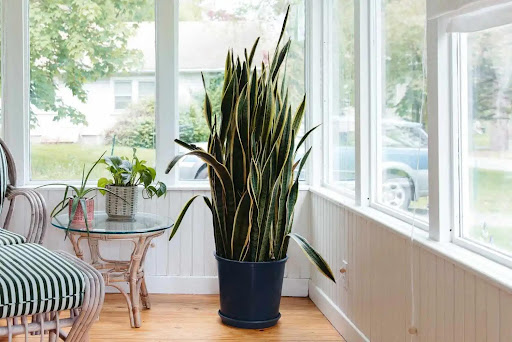Contents
- Importance of Indoor Air Purification
- How Indoor Plants Can Improve Air Quality
- Factors to Consider When Choosing Indoor Plants for Air Purification
- The 5 Best Plants for Indoor Air Purification
- 1. Peace Lily (Spathiphyllum)
- 2. Snake Plant (Sansevieria)
- 3. Boston Fern (Nephrolepis exaltata)
- 4. Aloe Vera (Aloe barbadensis)
- 5. Spider Plant (Chlorophytum comosum)
- Benefits of Each Plant for Air Purification
- How to Care for Indoor Plants for Optimal Air Purification
- Additional Tips for Improving Indoor Air Quality
- Common Misconceptions About Indoor Air Purification
- DIY Air Purifying Plant Projects
Importance of Indoor Air Purification
Indoor air quality is often overlooked, but it plays a crucial role in our overall health and well-being. Studies have shown that indoor air can be up to five times more polluted than outdoor air, mainly due to factors such as poor ventilation, synthetic materials, and household chemicals. This can lead to a range of health issues, including allergies, respiratory problems, and even long-term effects on cardiovascular health. One of the most effective ways to improve indoor air quality is by using plants for air purification. Not only do plants add beauty and a sense of calm to our living spaces, but they also act as natural air filters, removing harmful pollutants and releasing oxygen. They can help reduce the levels of volatile organic compounds (VOCs) commonly found in household products, such as cleaning agents and paints. By incorporating air-purifying plants into your home, you can create a healthier environment for you and your family.How Indoor Plants Can Improve Air Quality
Indoor plants have a unique ability to improve air quality through a process known as phytoremediation. This process involves the plants absorbing pollutants through their leaves and roots and then breaking them down or storing them in their tissues. The plants not only remove harmful substances from the air but also convert carbon dioxide into oxygen through photosynthesis. Moreover, plants increase humidity levels, which can be beneficial in dry indoor environments. Dry air can lead to respiratory problems, dry skin, and irritated mucous membranes. By releasing moisture through a process called transpiration, plants can help maintain optimal humidity levels, improving overall comfort and well-being.Factors to Consider When Choosing Indoor Plants for Air Purification
When selecting indoor plants for air purification, it’s essential to consider a few factors to ensure their effectiveness and longevity. First, assess the available space and lighting conditions in your home. Different plants have varying light requirements, so choose plants that can thrive in the available light levels. Next, consider your lifestyle and schedule. Some plants require more care and attention than others. If you have a busy lifestyle or tend to forget about plant care, opt for low-maintenance plants that can withstand periods of neglect. Lastly, consider any allergies or sensitivities you or your family members may have. While plants can improve air quality, some people may be allergic to certain types of pollen or plant fragrances. Choose plants that are less likely to trigger allergies and sensitivities.The 5 Best Plants for Indoor Air Purification
1. Peace Lily (Spathiphyllum)
The peace lily is not only a beautiful and elegant plant but also an excellent air purifier. It effectively removes common indoor pollutants, including formaldehyde, benzene, and trichloroethylene. Additionally, the peace lily has a high transpiration rate, which helps increase humidity levels in dry environments. This plant thrives in low to medium light conditions, making it suitable for various indoor spaces. It requires watering when the soil is dry to the touch, making it relatively low-maintenance. However, be cautious with pets or small children as the peace lily is toxic if ingested.2. Snake Plant (Sansevieria)
The snake plant, also known as mother-in-law’s tongue, is a popular choice for indoor air purification. It is known for its ability to filter formaldehyde, benzene, xylene, and trichloroethylene from the air. The snake plant is also incredibly resilient and can tolerate low light conditions, making it ideal for beginners or those with minimal natural light in their homes. This plant has low water requirements and thrives in well-draining soil. It is best to allow the soil to dry out between waterings to prevent root rot. The snake plant is also a great choice for bedrooms, as it emits oxygen at night, improving sleep quality.3. Boston Fern (Nephrolepis exaltata)
The Boston fern is a classic indoor plant that not only adds a touch of lush greenery to your home but also purifies the air. It is highly effective at removing formaldehyde, xylene, and toluene from indoor environments. The Boston fern prefers bright, indirect light and requires regular misting or a humidifier to maintain appropriate humidity levels. To ensure the health of your Boston fern, keep the soil evenly moist but not waterlogged. It is also important to provide good air circulation to prevent the growth of mold or mildew. With proper care, this plant can thrive and contribute to cleaner air in your home.4. Aloe Vera (Aloe barbadensis)
Aloe vera is not only a popular plant for its medicinal properties but also for its air-purifying abilities. It effectively filters formaldehyde and benzene from the air, commonly found in cleaning agents and paints. Aloe vera is a sun-loving plant and thrives in bright, indirect light. Water your aloe vera plant deeply but infrequently, allowing the soil to dry out between waterings. Overwatering can lead to root rot, so it’s important to ensure proper drainage. Aloe vera plants also produce offsets, or “pups,” which can be propagated and shared with friends or used to expand your indoor garden.5. Spider Plant (Chlorophytum comosum)
The spider plant is a popular choice for indoor air purification due to its ability to filter formaldehyde, xylene, and carbon monoxide from the air. It has long, arching leaves with white stripes, adding a touch of visual interest to any space. Spider plants thrive in bright, indirect light and are relatively low-maintenance. Water your spider plant when the top inch of soil feels dry to the touch. It is important to note that spider plants are mildly toxic to cats and dogs, so keep them out of reach of your furry friends.Benefits of Each Plant for Air Purification
Each of the five plants mentioned above offers unique benefits in terms of air purification. The peace lily, for example, not only filters pollutants but also increases humidity levels, making it an excellent choice for dry environments. The snake plant, on the other hand, is incredibly resilient and can tolerate low light conditions, making it suitable for various indoor spaces. The Boston fern is effective at removing formaldehyde, xylene, and toluene from the air, while the aloe vera plant filters formaldehyde and benzene. Lastly, the spider plant is known for its ability to filter formaldehyde, xylene, and carbon monoxide from indoor environments. By incorporating these plants into your home, you can enjoy cleaner, fresher air and experience the benefits of improved indoor air quality.How to Care for Indoor Plants for Optimal Air Purification
Caring for indoor plants not only ensures their longevity but also maximizes their air-purifying abilities. Here are some general care tips to keep in mind:- Lighting: Place plants in areas that receive adequate light for their specific requirements. Monitor the light levels and adjust the placement as needed.
- Watering: Follow the watering guidelines for each plant. Overwatering can lead to root rot, while underwatering can cause wilting and stunted growth. Use well-draining pots and allow the soil to dry out between waterings.
- Humidity: Some plants, such as the Boston fern, thrive in high humidity environments. Use a humidifier or mist the leaves regularly to maintain optimal humidity levels.
- Fertilization: Provide plants with the necessary nutrients by fertilizing them according to their specific needs. Use a balanced, water-soluble fertilizer and follow the instructions on the packaging.
- Pruning: Regularly remove dead or yellowing leaves to promote healthy growth and prevent the spread of diseases or pests.
Additional Tips for Improving Indoor Air Quality
In addition to incorporating air-purifying plants into your home, there are other steps you can take to improve indoor air quality:- Ventilation: Open windows and doors whenever possible to allow fresh air to circulate. Use exhaust fans in the kitchen and bathroom to remove pollutants and excess moisture.
- Reduce Chemical Use: Opt for natural, non-toxic cleaning products and avoid using strong chemicals indoors. Keep indoor air fresh by using natural air fresheners, such as essential oils or simmering herbs.
- Clean Regularly: Dust, vacuum, and mop regularly to remove dust, allergens, and pollutants from your home. Use a high-efficiency particulate air (HEPA) filter in your vacuum cleaner to trap smaller particles effectively.
- Control Humidity: Use a dehumidifier in damp areas to prevent the growth of mold and mildew. Maintain humidity levels between 30-50% to discourage the proliferation of allergens.
- Avoid Smoking Indoors: Smoking indoors releases harmful chemicals and toxins into the air. If you or a family member smokes, make an effort to do so outdoors to minimize indoor air pollution.
Common Misconceptions About Indoor Air Purification
There are several misconceptions surrounding indoor air purification. Let’s debunk some of the most common ones:- Myth: Plants produce oxygen at night. While it is true that plants release oxygen during the day through photosynthesis, they consume oxygen at night. It is not recommended to keep plants in bedrooms for oxygen production during sleep.
- Myth: One plant can purify an entire room. While plants can contribute to cleaner air, they cannot purify an entire room on their own. To achieve significant air purification, multiple plants should be strategically placed throughout the space.
- Myth: All indoor plants are safe for pets. While many indoor plants are safe for pets, some can be toxic if ingested. It is crucial to research and choose pet-friendly plants if you have furry friends in your home.
- Myth: Air purifiers are unnecessary with indoor plants. While indoor plants can improve air quality, they may not remove all pollutants effectively. Air purifiers can complement the air-purifying abilities of plants, especially in areas with high levels of pollution.
DIY Air Purifying Plant Projects
If you’re feeling creative, you can take your indoor air purification efforts to the next level by creating DIY air purifying plant projects. Here are a few ideas to get you started:- Terrarium with Air-Purifying Plants: Create a mini ecosystem by building a terrarium with air-purifying plants, such as mosses, ferns, or small spider plants. The enclosed environment will enhance humidity levels and improve air quality.
- Hanging Herb Garden: Grow herbs such as basil, mint, or rosemary indoors, either in hanging planters or small pots. These herbs not only add fragrance and flavor to your cooking but also filter the air and remove volatile organic compounds.
- Vertical Garden: Construct a vertical garden using a trellis or hanging planters. Choose air-purifying plants with trailing or climbing habits, such as pothos or English ivy, to create a stunning living wall that also improves air quality.
- Living Air Freshener: Combine air-purifying plants with natural air fresheners, such as dried lavender or citrus peels, to create a living air freshener. Place the plants in a decorative basket or planter and add the dried herbs or citrus peels for a refreshing scent.









